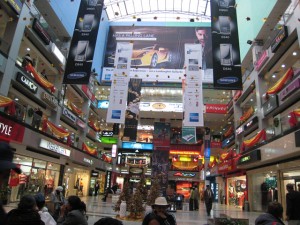By: Vivek Kaul, Head – Retail Services CBRE South Asia
 Track2Realty: With the rapidly changing profile of consumers the world over, it remains a challenge for retailers to keep up with shifting shopping demands. Shoppers today are more discerning and better informed about products and services than ever before, expecting a certain standard of shopping experience from retailers.
Track2Realty: With the rapidly changing profile of consumers the world over, it remains a challenge for retailers to keep up with shifting shopping demands. Shoppers today are more discerning and better informed about products and services than ever before, expecting a certain standard of shopping experience from retailers.
This might be a global trend, but in today’s globalized environment, similar consumer trends may be replicated across most local markets too—including that of India.
Each local market has its own distinct characteristics to which retailers need to adapt themselves to stay ahead of the game. Processes and approaches which work in the home country of a brand, may not necessarily work as efficiently in othergeographies. Local preferences, traditions, tastes and preferences, besides real estate dynamics—suchas operating infrastructure and costs—have to be kept in mind to ensure a successful foray into a foreignmarket place.
Despite the structural challenges and bureaucratic bottlenecks that the Indian retail market suffers from, global retailers have been queuing up to enter and establish their footprint in the market, as they are aware of its potential growth opportunities. Growth has almost plateaued in most developed markets, providing little room for retailers to drive their business expansion amid growing competition across segments.
The Indian market being largely underpenetrated, offers significant opportunity forgrowth—especially in segments such as F&B, fashion apparel, and luxury goods—due to factors such as an expanding middle class, rising disposable incomes, and a growing appetite for international quality goods and services among Indian consumers.
The Indian market, however, continues to face significant challenges to growth in the form of inadequate quality retail real estate space, restrictive legislation policies, and infrastructure bottlenecks. These challenges tend to impede India’s retail story, and restrict the market from attaining itstrue potential.
Some of the key challenges that retailers face in India include:
- Real estate rentals,
- Real estate quality,
- Slowing consumerism,
- MRP constraints,and
- Policy issues
Policy issues: FDI norms
The erstwhile Indian government’s move to open the country’s retail sector to foreign supermarkets has been anticipated for some time, and is regarded by market experts as being crucial to re-launching the country’s flagging economy. Supporters of the new policy say the entry of international supermarket retailers will help bring down soaring prices, make the retail sector more competitive, and help modernizeits ageing infrastructure and distribution systems. Small and medium sized family-run retailers will survive, they say, as they offer a valuable local service that large supermarkets are unsuited to provide.
According to the Confederation of Indian Industry (CII), such a move would likely increase the income of producers across sectors by about US$ 35–45 billion peryear, creating approximately 3–4 million jobs with retail chains, and about 4–6 million jobs in the logistics sector, other than creating a demand for more contract labor in distribution and repackaging centers and functions such as housekeeping and security.
According to a recent announcement made by the Ministry of Commerce and Industry, the new government has decided to disallow FDI in multi-brand retail in the country, which would have led to increased consumer demand, catalyzing greater investment opportunities in organized retail in India. As FDI in multi -brand retail encompasses big ticket investments; individual as well as institutional investors would have been more willing to make commitments towards the retail sector in India.
The key beneficiaries of such investment inflows would have been cities with population bases of one million or more, with phased benefits percolating to other locations as well.Vacancy levels wouldhave dropped as hypermarket chains would have been likely to occupy large spaces across cities. The country’s logistic sector would also have benefitted significantly, as leading global players likely invested hugeamounts in logistics and supply chain techniques to reduce wastages and allow for faster delivery of perishable goods.
Impact analysis of FDI in Retail
| Impact Analysis | Today | Tomorrow |
| FARMERS | • Travel long distances to sell to intermediaries• Price offered is less than 50% of retailprice
• Cheated on quality and weight |
• Sell produce at higher prices at farm collection centers• Distances reduced, sale within close proximity of place of produce
• Knowledge transfer, improved yields, electronic weight systems |
| IMPORTERS | • Import variety of products at high import duties• These products sold to small retailers | • Final price to reduce as large retailers with more bargaining power will import these products from their sources across the world |
| MIDDLEMEN | • Vegetables and fruits pass through multiple channels: aggregator, market trader, wholesaler, sub-wholesaler and retailer• Multiple channels leads to wastage(~25%) and increased price | • Large retailers to source directly from the farmer• Only one level of intermediary required – the aggregator would beneeded |
| SMEs | • Small and medium enterprises have no direct access to large retailers• Mostly the “ responsibility” of the Government to promote these industries | • Direct access to retailers would eliminate middlemen currently eating into their margins• Mandatory sourcing of 30% from SMEs to ensure higher income and better bargaining power |
| CONSUMERS | • Consumers shop at malls peppered across cities; grocery shopping done mostly from neighborhood stores | • Deep discounts across a wide spectrum of products• Increased competition likely to lead toreduction in price levels and improved shopping experience |
| Source: CBRE Research | ||





